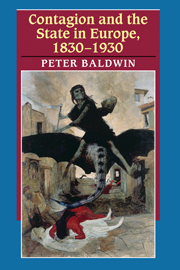Chapter 5 - Syphilis between prostitution and promiscuity
Published online by Cambridge University Press: 29 June 2009
Summary
Venereal disease (for the purposes here primarily syphilis) complicated the problems of prophylaxis. Cholera and smallpox were acute epidemic diseases that quickly ran their course with evident external symptoms and a disabling effect on the victim. Identifying the stricken was therefore simple: they were usually in no position to object to precautions imposed and, indeed, had reason to seek the care that usually accompanied them. Syphilis, in contrast, whatever its origins, spread widely in the sixteenth century and by the nineteenth was endemic, afflicting a large (circa a tenth of adult urban males) fraction of the population. Its nature, with a surreptitious, protracted development and often painless symptoms, meant that it could be dissimulated and hidden by its sufferers, many of whom did not in fact realize they were ill, and the afflicted accordingly had ample opportunities to act as vectors of transmission. Symptoms neither necessarily drove the stricken to seek care nor prevented them from living life as usual. In fact, in the days before salvarsan and then penicillin, the protracted and unpleasant treatments that medicine had to offer were more inconvenient and debilitating than the disease. Because transmission generally required direct contact with permeable membranes, syphilis was in theory more easily preventable than diseases with more diffuse and multiple pathways of contagion. Because instinct nonetheless brought such membranes into frequent contact, in fact syphilis became among the most widely disseminated of transmissible ailments, spreading eventually the world over.
- Type
- Chapter
- Information
- Contagion and the State in Europe, 1830-1930 , pp. 355 - 523Publisher: Cambridge University PressPrint publication year: 1999
- 1
- Cited by



